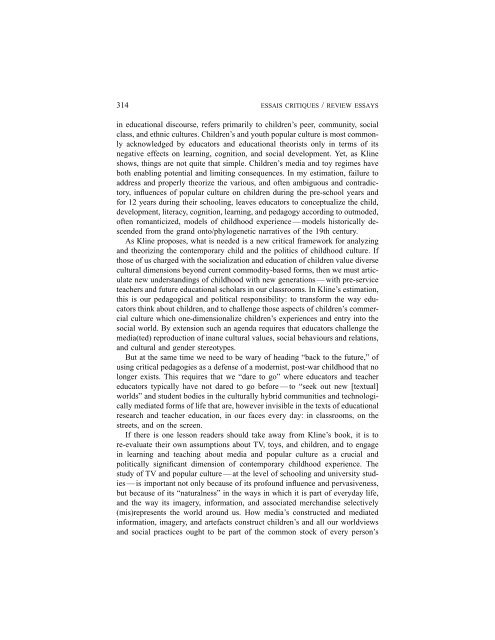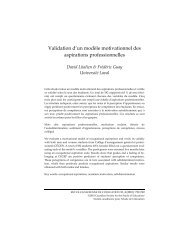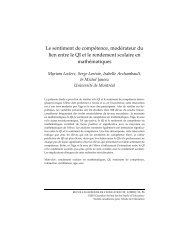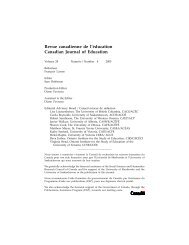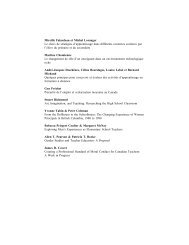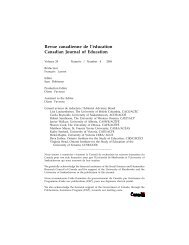Essai Critiques / Review Essays Out of the Garden and Into the Mall
Essai Critiques / Review Essays Out of the Garden and Into the Mall
Essai Critiques / Review Essays Out of the Garden and Into the Mall
Create successful ePaper yourself
Turn your PDF publications into a flip-book with our unique Google optimized e-Paper software.
314 ESSAIS CRITIQUES / REVIEW ESSAYS<br />
in educational discourse, refers primarily to children’s peer, community, social<br />
class, <strong>and</strong> ethnic cultures. Children’s <strong>and</strong> youth popular culture is most commonly<br />
acknowledged by educators <strong>and</strong> educational <strong>the</strong>orists only in terms <strong>of</strong> its<br />
negative effects on learning, cognition, <strong>and</strong> social development. Yet, as Kline<br />
shows, things are not quite that simple. Children’s media <strong>and</strong> toy regimes have<br />
both enabling potential <strong>and</strong> limiting consequences. In my estimation, failure to<br />
address <strong>and</strong> properly <strong>the</strong>orize <strong>the</strong> various, <strong>and</strong> <strong>of</strong>ten ambiguous <strong>and</strong> contradictory,<br />
influences <strong>of</strong> popular culture on children during <strong>the</strong> pre-school years <strong>and</strong><br />
for 12 years during <strong>the</strong>ir schooling, leaves educators to conceptualize <strong>the</strong> child,<br />
development, literacy, cognition, learning, <strong>and</strong> pedagogy according to outmoded,<br />
<strong>of</strong>ten romanticized, models <strong>of</strong> childhood experience — models historically descended<br />
from <strong>the</strong> gr<strong>and</strong> onto/phylogenetic narratives <strong>of</strong> <strong>the</strong> 19th century.<br />
As Kline proposes, what is needed is a new critical framework for analyzing<br />
<strong>and</strong> <strong>the</strong>orizing <strong>the</strong> contemporary child <strong>and</strong> <strong>the</strong> politics <strong>of</strong> childhood culture. If<br />
those <strong>of</strong> us charged with <strong>the</strong> socialization <strong>and</strong> education <strong>of</strong> children value diverse<br />
cultural dimensions beyond current commodity-based forms, <strong>the</strong>n we must articulate<br />
new underst<strong>and</strong>ings <strong>of</strong> childhood with new generations — with pre-service<br />
teachers <strong>and</strong> future educational scholars in our classrooms. In Kline’s estimation,<br />
this is our pedagogical <strong>and</strong> political responsibility: to transform <strong>the</strong> way educators<br />
think about children, <strong>and</strong> to challenge those aspects <strong>of</strong> children’s commercial<br />
culture which one-dimensionalize children’s experiences <strong>and</strong> entry into <strong>the</strong><br />
social world. By extension such an agenda requires that educators challenge <strong>the</strong><br />
media(ted) reproduction <strong>of</strong> inane cultural values, social behaviours <strong>and</strong> relations,<br />
<strong>and</strong> cultural <strong>and</strong> gender stereotypes.<br />
But at <strong>the</strong> same time we need to be wary <strong>of</strong> heading “back to <strong>the</strong> future,” <strong>of</strong><br />
using critical pedagogies as a defense <strong>of</strong> a modernist, post-war childhood that no<br />
longer exists. This requires that we “dare to go” where educators <strong>and</strong> teacher<br />
educators typically have not dared to go before — to “seek out new [textual]<br />
worlds” <strong>and</strong> student bodies in <strong>the</strong> culturally hybrid communities <strong>and</strong> technologically<br />
mediated forms <strong>of</strong> life that are, however invisible in <strong>the</strong> texts <strong>of</strong> educational<br />
research <strong>and</strong> teacher education, in our faces every day: in classrooms, on <strong>the</strong><br />
streets, <strong>and</strong> on <strong>the</strong> screen.<br />
If <strong>the</strong>re is one lesson readers should take away from Kline’s book, it is to<br />
re-evaluate <strong>the</strong>ir own assumptions about TV, toys, <strong>and</strong> children, <strong>and</strong> to engage<br />
in learning <strong>and</strong> teaching about media <strong>and</strong> popular culture as a crucial <strong>and</strong><br />
politically significant dimension <strong>of</strong> contemporary childhood experience. The<br />
study <strong>of</strong> TV <strong>and</strong> popular culture — at <strong>the</strong> level <strong>of</strong> schooling <strong>and</strong> university studies<br />
— is important not only because <strong>of</strong> its pr<strong>of</strong>ound influence <strong>and</strong> pervasiveness,<br />
but because <strong>of</strong> its “naturalness” in <strong>the</strong> ways in which it is part <strong>of</strong> everyday life,<br />
<strong>and</strong> <strong>the</strong> way its imagery, information, <strong>and</strong> associated merch<strong>and</strong>ise selectively<br />
(mis)represents <strong>the</strong> world around us. How media’s constructed <strong>and</strong> mediated<br />
information, imagery, <strong>and</strong> artefacts construct children’s <strong>and</strong> all our worldviews<br />
<strong>and</strong> social practices ought to be part <strong>of</strong> <strong>the</strong> common stock <strong>of</strong> every person’s


